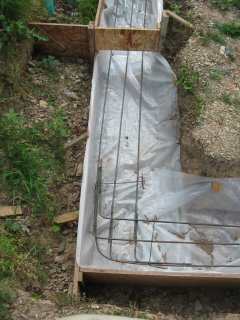The Rebar Adventure


So, now it's time to start cutting and bending rebar. A couple of weeks earlier one of the local stores had a 15% off sale on everything; so I bought all 200 pieces of my rebar (10' lengths). My original rebar estimate was for about 184 pieces, and it seems I've heard regularly that you should plan on 10% waste; so 200 pieces seemed about right. For those of you with building experience, you're probably thinking even 184 pieces is WAY too many. But remember, this is a dry stack project, so there is a LOT of rebar that runs vertically inside the concrete block.
So, I rent a rebar cutter-bender, which is this big hundred pound jaw-like thing that has a 6' steel bar you pull on to cut or bend the rebar (before it's over you'll wish that bar was 8' long). I picked it up at 4:30 pm and still having a few hours of daylight left thought I'd get a head start on the job. I'll bet I cut 50 pieces of rebar before supper that night. Good thing I did, because the next day I used every bit of my remaining time to get the job finished.
A little side note here for those of you wanting to build your own house. We have maybe five or six tool rental businesses here. Only two of them even had a rebar cutter-bender. But the rental rates for the two stores were drastically different; ie $16 a day vs $40 a day. I rechecked after hearing both prices; they were for the same type and size equipment. And, the cheaper store was kind enough to put in a new set of cutter blades when I rented it from them. So, take the time to shop around; you can save yourself some bucks. These people are also nice enough that if you need to just cut or bend a couple of pieces of rebar you don't have to rent the machine for a whole day; they will let you use it at their shop; just bring your own rebar.
The two pics are the south wall. You can see the double set of form boards in the bottom picture (that weren't shown in previous post). Most people don't put visqueen (plastic sheeting) under the footers, but I did. The plastic keeps water from migrating through the finished concrete via a process known as capillary flow. Most builders put visqueen under the main slab to prevent water migration. To me it seems reasonable to put it under the footer for the same reason (and my "Builder's Guide to Mixed Climates" book (by Joe Lstiburek, Taunton Press) says to do it too). Keeping my crawlspace nice and dry by getting rid of every possible entryway for moisture seems a wise and prudent thing to do. Maybe something this simple will help prevent me from having to buy and use a dehumidifier in the crawlspace.

0 Comments:
Post a Comment
<< Home